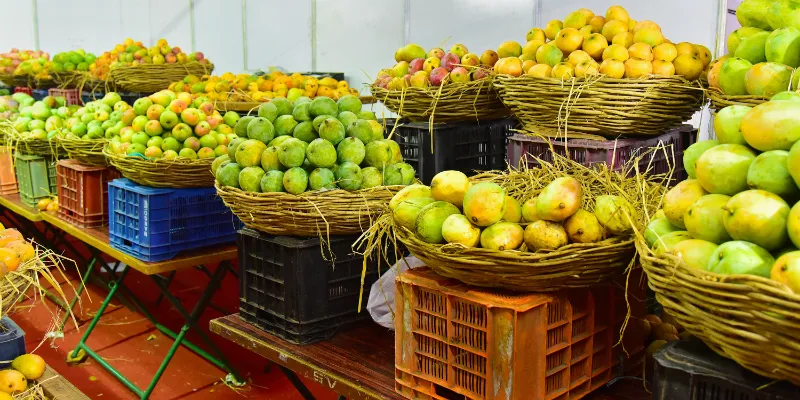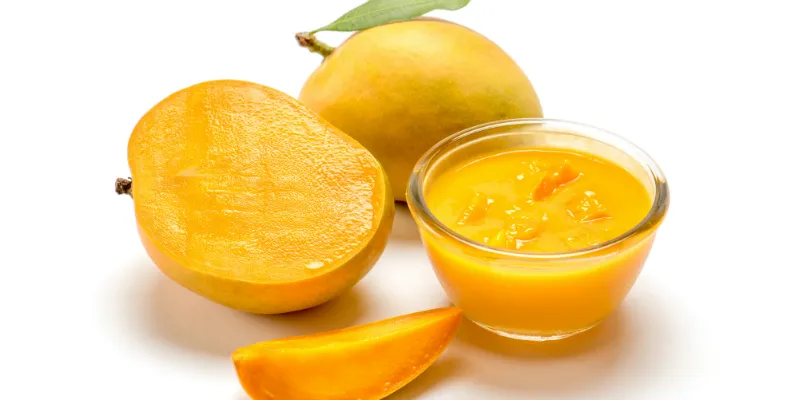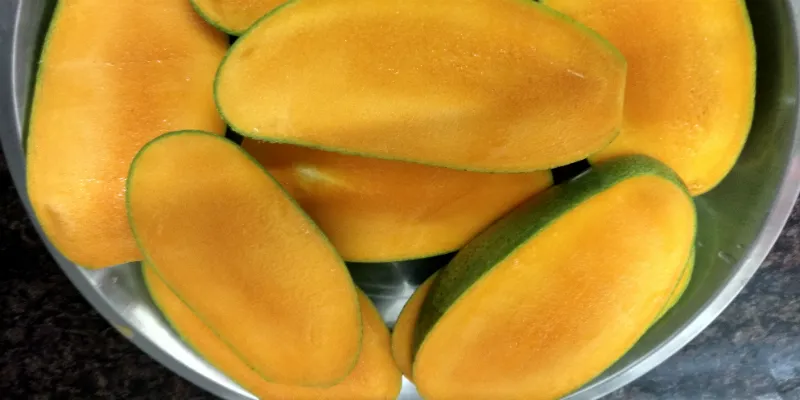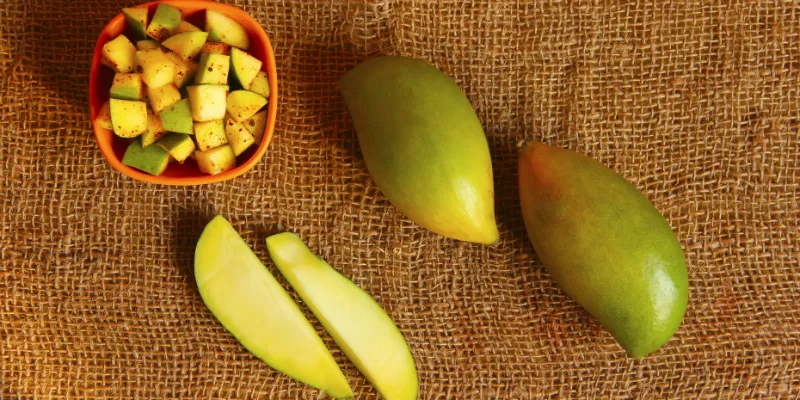Catch the mango mania this summer
Summer is synonymous with mangoes, but did you know your choice of mango says more about you than you realise? Check out all the mango varieties out there this year and figure out new ways of serving this delicious fruit...
Besides air-conditioning, the only thing that makes the heat and dust of summer bearable is the mango. We are fortunate to live in a country with an abundance of this divine fruit, with a variety and price point to delight both prince and pauper: while the former can feast on the legendary Alphonso, the latter is a sucker, pun intended, for the humble choosa.
Quiz question: which is the most popular fruit in the world? Go to the top of the class, Sherlock, it is indeed the mango, first developed in India more than 5,000 years ago.
If you are looking for additional trivia to impress your Whatsapp gang, the mango symbolises love and friendship and some varieties of mango trees can grow as tall as 35m. If you’re a multi-vitamin freak, chuck the bottle away: a mango can provide 100% of your daily Vitamin C, 25% of Vitamin A and 12% of your recommended daily fibre intake. Mangoes contain potassium, which helps in controlling blood pressure and antioxidants, also known as “free radical scavengers”, which offer protection against breast and colon cancers.
So, let the British believe in the myth of an apple a day, we desis can stay calm by eating aam.

The markets are full of different types of mangoes
Everyone has their favourite mango story and while I can tell you mine, I’m going to have to imagine yours. As kids, we would pluck a basketful of a variety called Banganapalli from the tree in our garden. These were carefully placed in an earthenware rice jar in the storeroom and we would wait impatiently for them to ripen.
The Banganapalli, grown in the very heart of Andhra Pradesh, tastes somewhat similar to a North Indian Safeda. It is bright yellow in colour, not too fibrous and has a remarkable fragrance especially when ripened in raw rice, so the flesh has a delicate, kulfi-like consistency. I know Maharashtrians turn purple with rage when anyone suggests that the Alphonso has met its match, but eat your heart out Mumbaikars, the Banganapalli has no parallel.

Alphonso mangoes are often called the king of mangoes
We often went on day trips to Elliot’s Beach where the highpoint was Aunt Marie’s magical mango fool. Playing beach cricket in the murderous heat of Chennai, cooling off in the Bay of Bengal and then slurping down a chilled glass of Aunty’s fool was sheer bliss.

Mango smoothies are very popular in summer
Of course, we hadn’t heard of smoothies then but that’s exactly what this was: tart fruit, delicate balance of sweet and sour, touch of rock salt, a hint of jaggery and an elusive grace note of lime: Man, this was divine.
My Bengali friends rave about Himsagar, known as Maldahi in Odisha and Bihar, which has the shortest season and is available only in June. The Himsagar is thin-skinned fruit with a sunny golden lustre, smooth, silky flesh and is as sweet as a rossogolla. Then there’s the Dasheri, perhaps the oldest variety of mango in India, cultivated mainly in UP. Also known as Malihabadi, the fruit is sweet and succulent with a distinctive aroma and a long, almond-like shape.

Dasheri mangoes are known for their delicious sweetness and succulence
The Mallika varietal is a relatively newer Neelam-Dasheri hybrid renowned in Karnataka where it is relished across all communities for its rich fibreless orange pulp which devotees say is sweeter than honey. Then there’s the Malgova, grown in Tamil Nadu which is enormous; these can sometimes weigh a kilo a piece and some call it the ‘Alphonso of South India’. The Malgova’s sweetness is balanced with a slightly tart aftertaste and the best way to check it for ripeness is to look at the top of the fruit: when it acquires a pink blush, it is perfectly ripe.
Also read: From Ruby chocolate to Sao Tome cocoa and Madagascar beans: Learnings from a chocolate workshop
Other lesser varietals are Pairis, found in Goa and coastal Maharashtra. Dude, chill out, God gave you feni, you want good mangoes also? Pairis are decidedly inferior with a reddish skin, mildly spicy aroma and fibreless flesh bringing to mind an Englishman who has been broiled to a lobsterish red by the Goan sun.
At the bottom of the pole, is the humblest of all, the Totapuri, which is used principally for mango pulp in the food processing industry. Shaped rather like a parrot’s beak, the fruit is greenish in colour tinged with red. Call me biased, but it tastes best eaten raw with chilli powder and salt.

The Totapuri mango tastes best with chilli powder and salt
The last great Mughal poet, Mirza Ghalib, was out for a stroll near Red Fort with Bahadur Shah Zafar when the emperor realised that his companion was not paying attention to him but was staring intently at a mango orchard. Perturbed the emperor asked him why he was staring at the trees.
Ghalib is said to have replied, ‘Badshah, the wise say that each morsel on earth has the name of the person who will eat it, I am looking to see if any of these trees has the name of my father or forefathers etched on the trunk.”
The emperor took the hint and thereafter a basket of mangoes from that very orchard was sent to the poet throughout the season. Ghalib’s fondness for mangoes was almost an obsession; apparently, he spent hours wondering what qualities a mango should possess to be called Naazuk-Pasand, one preferred by the delicate, or Rahmat-e-Khaas, a special grace?
So, pick your mangoes carefully, because your choice of mango says more about you than you realise…
Here’s my favourite mango recipe..
AUNT MARIE'S MANGO FOOL
Ingredients:
1/2 kg raw mango
2 tbsp jaggery
2 tsp roasted cumin powder
1/12 tsp black salt (kala namak)
1 cup fresh mint leaves
Ice cubes
Method:
1. Cook the mangoes with skin on, in a pressure cooker.
till soft. One whistle on high and 2 on low, around 7 minutes.
2. Remove the pressure cooker from heat and let the mangoes cool down.
3. De-skin and mash the mangoes to extract the pulp.
4. Do not discard the water.
5. Add 5-6 cups of water to the existing water.
6. Lightly crush the mint leaves.
7. Add the mint, jaggery, roasted cumin powder and black salt to the
mango pulp mixed with water.
8. Mix well, top with ice cubes and serve.
SHRIMP, MANGO & AVOCADO TERRINE
There is something about the green creaminess of the avocado paired with the mango that creates a synergy which is greater than the sum of its parts. And so, I’d like to pay tribute to a classic of 60's: those elegant, wobbly, gelatin mousses. Which is how this avocado, mango and shrimp aspic evolved, with a kick of Thai and a hint of spice. Perfect for a lazy Sunday summer lunch.
Make sure your mango and shrimp pieces are small enough to fit in one slice. If they are too big, it becomes hard to cut neatly. The avocado can be larger since it is easier to slice through.
To turn it vegan, substitute agar-agar for gelatin and omit the shrimp.
Ingredients:
12 medium size shrimp.
1/3cup coriander stems, finely chopped
2 tablespoon fish sauce
3 tablespoons lime juice
2 teaspoons jaggery
1 tablespoon jalapeno or fresh green chilli, finely chopped
The Terrine
1 ½ cups ripe mango, cubed into small pieces.
¼ cup spring onion, finely sliced
4 tablespoons lime juice
1 pinch salt
10 twists of black pepper
3 cups ripe avocado, halved and sliced
2 teaspoons jalapeno, sliced paper thin
6 mint leaves, torn
2/3 cup very hot water and 1 tbsp gelatin
Lime juice from 3 limes
1 tablespoon jaggery
Salt to taste
1 tablespoon fish sauce
Method:
1. In a bowl, toss cleaned shrimp with all the ingredients of the marinade and leave for an hour to marinate.
2. Heat a little oil in a pan and pan fry the shrimp till pink. Remove.
3. Add the marinade ingredients to the pan and reduce till sticky. Pour over the shrimp and allow it to cool.
4. When cool, slice each shrimp into 3-4 pieces, about 1/4" at most. Reserve.
The Terrine
1. For the terrine you need a medium-sized glass mould.
2. In a small bowl combine the mango cubes with the 1/4 cup leeks, lime juice, salt and pepper and marinate for an hour. After an hour, strain the mango and reserve the marinade.
3. In a small bowl dissolve the gelatin in the hot water. When it has completely dissolved add the lime juice, jaggery, salt, fish sauce. Also add the reserved liquid from the mango. Allow the mixture to cool a little.
4. Add a single layer of avocado, keep in mind this will be the top of your terrine, once it is turned out.
5. Add a layer of mango cubes.
6. Sprinkle the spring onion and mint across in a fine layer.
7. Add half the shrimp.
8. Add a layer of avocado and the rest of the mango.
9. Add the rest of the shrimp
10. Add a final avocado layer (which will be the base of the terrine, when turned out).
11. Now pour the gelatin mixture carefully over the contents of the terrine to just cover the top layer of avocado. Put a sheet of wax proof paper over the top and gently press down if the avocado is a little above the liquid surface. Refrigerate until set, and keep it covered with clingfilm.
12. To unmould, slide a warmed knife around the edges of the terrine.
13. Place a board or large flat plate over the terrine and flip, shaking firmly until you hear a satisfying plop!
14. If the terrine is stuck for some reason, dip the base of the dish in a basin of boiling water for a few seconds, take a deep breath and repeat the process.
15. To serve, slice with a very sharp small knife, point down, and lift the slices carefully with a pie-server.
Also read: It is a plate full of stories at the Hungry Travellers Café







